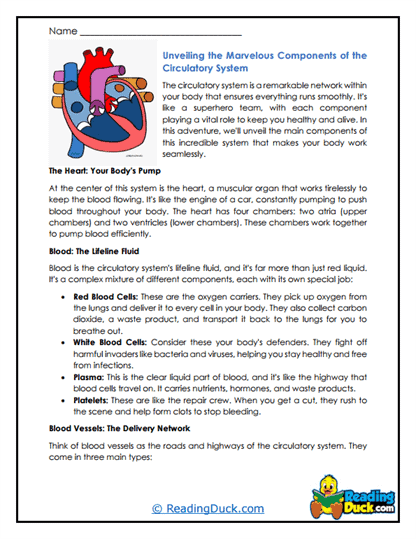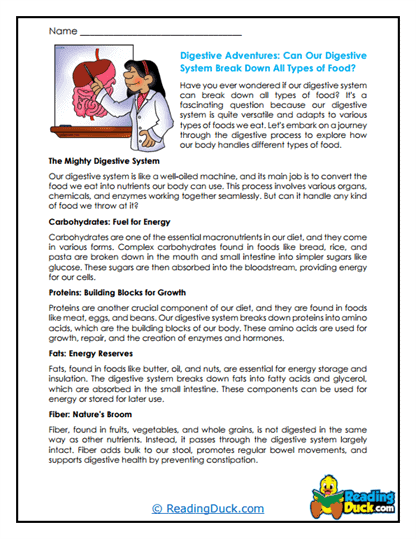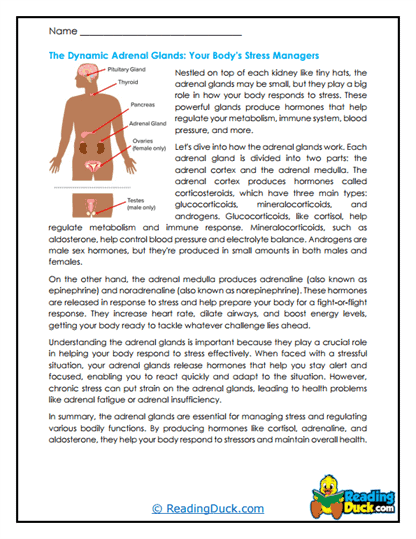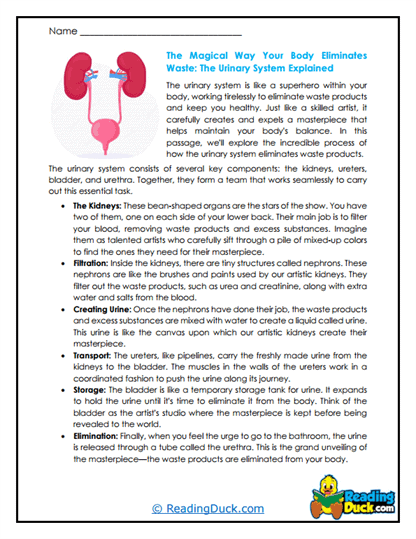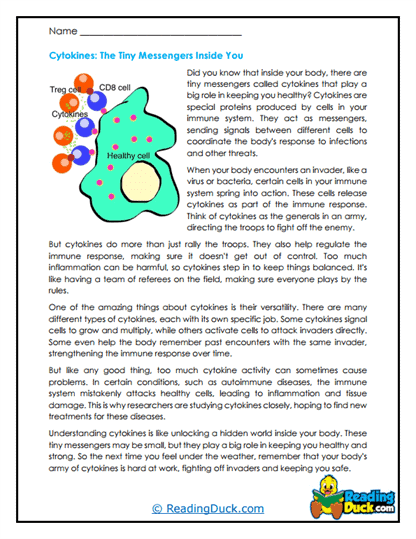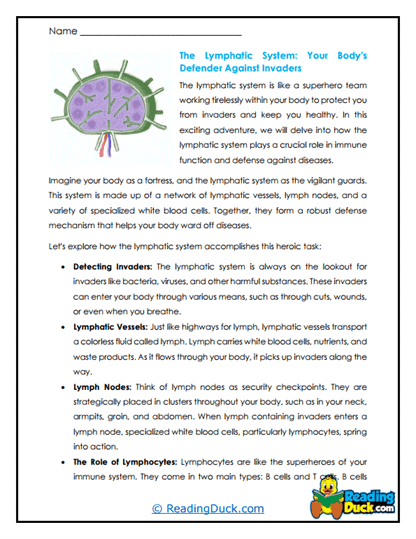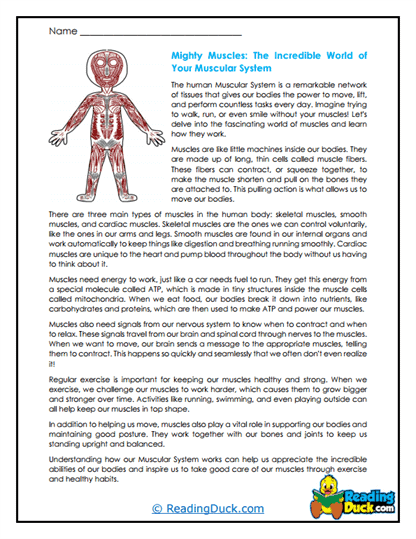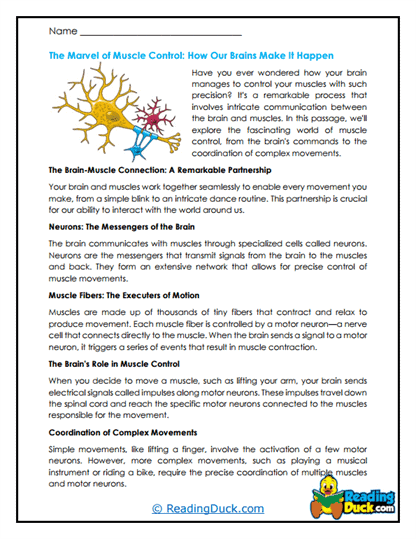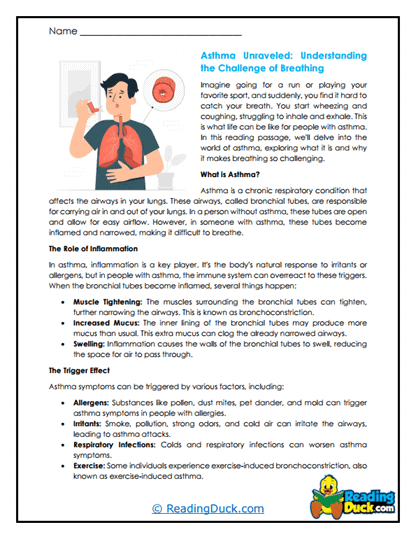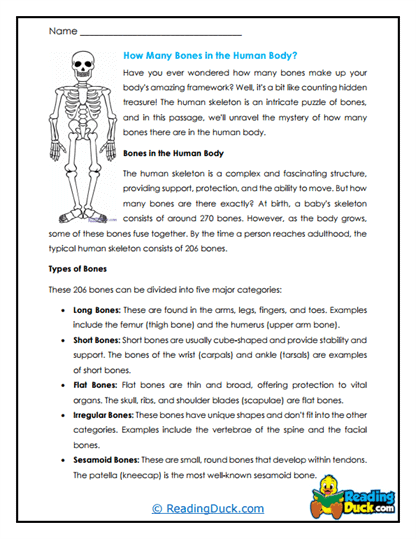Human Body Worksheets
About Our Human Body Worksheets
Our Human Body worksheets provide an in-depth exploration of the fascinating and complex systems that make up the human body. This collection, a subtopic within Biology, covers ten major systems of the body: Circulatory, Digestive, Endocrine, Excretory, Immune, Lymphatic, Muscular, Nervous, Respiratory, and Skeletal. Each system is examined through a series of worksheet sets that include informative reading passages, visually engaging images, and a variety of comprehension questions. These resources are designed to deepen students’ understanding of how the human body functions and encourage critical thinking about health and biology.
Each worksheet set contains:
- Multiple Choice Questions: These questions test students' comprehension of the reading material, helping to ensure they have understood the key concepts presented.
- Short Answer Questions: This section encourages students to articulate their understanding in their own words, reinforcing their knowledge and enhancing their ability to communicate scientific information effectively.
- Open-Ended Questions: These questions prompt students to share their personal thoughts, opinions, and reflections on the material, fostering a deeper connection to the content and promoting critical thinking.
An answer key is provided for every question sheet, making it easy for educators and parents to review students’ work. All worksheets are available as PDF files, ensuring they can be easily viewed electronically, downloaded, and printed.
Exploring the Human Body: Understanding Our Biological Systems
The human body is a marvel of biological engineering, with each system playing a vital role in maintaining life and health. When teaching students about the human body, it’s essential to break down these complex systems into manageable parts, helping them understand not only how each system works but also how they interact to keep the body functioning smoothly.
Here’s an overview of the key systems covered in this collection:
- Circulatory System: The circulatory system is responsible for transporting blood, nutrients, gases, and wastes to and from the cells of the body. It includes the heart, blood vessels, and blood. Understanding how the heart pumps blood through arteries, veins, and capillaries is crucial for grasping how oxygen and nutrients reach every part of the body. Students can explore topics like the structure of the heart, the path of blood circulation, and the importance of maintaining cardiovascular health.
- Digestive System: This system breaks down food into nutrients that the body can use for energy, growth, and repair. It includes organs such as the mouth, esophagus, stomach, intestines, liver, and pancreas. Students learn about the process of digestion, from the mechanical breakdown of food to the chemical digestion by enzymes, and how nutrients are absorbed into the bloodstream. Topics like metabolism, digestive disorders, and the importance of a balanced diet are also covered.
- Endocrine System: The endocrine system regulates bodily functions through hormones, which are chemical messengers produced by glands such as the thyroid, adrenal glands, and pancreas. This system controls processes like growth, metabolism, and reproduction. Students can delve into how hormones influence various body functions, the role of different glands, and the impact of hormonal imbalances on health.
- Excretory System: The excretory system removes waste products from the body, maintaining a stable internal environment. It includes the kidneys, ureters, bladder, and urethra. Students explore how the kidneys filter blood, how urine is formed and excreted, and the importance of maintaining healthy kidneys and urinary function.
- Immune System: The immune system defends the body against pathogens, such as bacteria, viruses, and other harmful invaders. It includes white blood cells, antibodies, the lymphatic system, and various organs like the spleen and thymus. Students learn how the body detects and fights off infections, the role of vaccines, and the importance of maintaining a strong immune system through good nutrition and hygiene.
- Lymphatic System: This system is closely associated with the immune system and circulatory system, playing a role in fluid balance, fat absorption, and immune responses. It includes lymph nodes, lymphatic vessels, and lymph, as well as organs like the spleen and tonsils. Students can explore how the lymphatic system helps protect the body from disease, the process of lymphatic drainage, and the connection between the lymphatic and circulatory systems.
- Muscular System: The muscular system enables movement, maintains posture, and produces heat. It includes all the muscles in the body, from large skeletal muscles to the smooth muscles in organs and the cardiac muscle in the heart. Students learn about different types of muscles, how muscles work with the skeletal system to produce movement, and the importance of exercise and nutrition in maintaining muscle health.
- Nervous System: The nervous system controls and coordinates body activities by transmitting signals between different parts of the body. It includes the brain, spinal cord, and nerves. Students explore how the nervous system processes information, the structure and function of neurons, and the role of the central and peripheral nervous systems. Topics like reflex actions, sensory organs, and neurological disorders are also discussed.
- Respiratory System: This system supplies the body with oxygen and removes carbon dioxide through breathing. It includes the lungs, trachea, bronchi, and diaphragm. Students learn about the process of gas exchange, the mechanics of breathing, and how the respiratory system works with the circulatory system to deliver oxygen to cells and remove carbon dioxide. The impact of respiratory diseases and the importance of maintaining lung health are also covered.
- Skeletal System: The skeletal system provides structure to the body, protects internal organs, and allows movement in conjunction with the muscular system. It includes bones, joints, cartilage, and ligaments. Students can explore the structure of bones, the different types of joints, and how bones grow and repair. Topics like osteoporosis, bone health, and the role of the skeletal system in blood cell production are also discussed.
By studying these systems, students gain a comprehensive understanding of how the human body functions as a whole. These worksheets help break down complex concepts into digestible information, making it easier for students to grasp the intricacies of each system and appreciate the marvel of human biology.
Using These Worksheets in School or Homeschool
These Human Body worksheets can be used effectively in both school and homeschool settings. Here are some tangible ideas for incorporating these worksheets into a learning curriculum:
- Sequential Learning Modules: Teachers and parents can organize the study of the human body into a series of modules, focusing on one system at a time. Begin with an introductory lesson on the system, using the reading passages and pictures to provide a foundational understanding. Follow up with the multiple choice, short answer, and open-ended questions to assess comprehension and encourage critical thinking. This approach allows students to build their knowledge systematically.
- Cross-Curricular Integration: The Human Body worksheets can be integrated with other subjects, such as health education, physical education, and even art. For example, students can create detailed diagrams of the systems they are studying, label them, and explain their functions. They can also connect their learning to real-world health topics, such as the importance of a balanced diet (Digestive System) or the benefits of regular exercise (Muscular and Skeletal Systems).
- Group Activities and Discussions: These worksheets can be used in group settings to promote collaboration and discussion. After completing the worksheets individually, students can work in small groups to compare answers, discuss their reflections on the open-ended questions, and present their findings to the class. This not only reinforces their understanding but also enhances their communication and teamwork skills.
- Hands-On Projects and Experiments: To complement the worksheets, teachers and parents can organize hands-on activities and experiments related to the human body systems. For instance, students can build models of the heart or lungs, conduct simple experiments to understand how muscles work, or use online simulations to explore how the nervous system transmits signals. These activities make learning more interactive and engaging.
- Assessment and Review: The answer keys provided with the worksheets make it easy to assess students’ understanding and identify areas where they may need further review. Teachers and parents can use these worksheets as a tool for both formative and summative assessment, ensuring that students have a solid grasp of the material before moving on to more advanced topics.
By using these worksheets creatively and effectively, educators can provide a comprehensive and engaging learning experience that deepens students’ understanding of the human body and fosters a lifelong interest in biology.
The Importance of Understanding the Human Body
Learning about the human body is essential for students, both academically and personally. On an academic level, understanding the body’s systems provides a foundation for advanced studies in biology, health sciences, and medicine. It also enhances critical thinking and problem-solving skills as students explore how different systems interact and what happens when things go wrong.
On a personal level, knowledge of the human body empowers students to make informed decisions about their health and well-being. Understanding how their bodies function helps them develop healthy habits, recognize the signs of illness, and appreciate the importance of preventive care. It also fosters a sense of curiosity and respect for the complexity of life, encouraging students to explore the natural world and their place within it.
Overall, these Human Body worksheets provide a valuable resource for educators and students alike, offering a detailed and engaging exploration of one of the most fascinating subjects in science.
